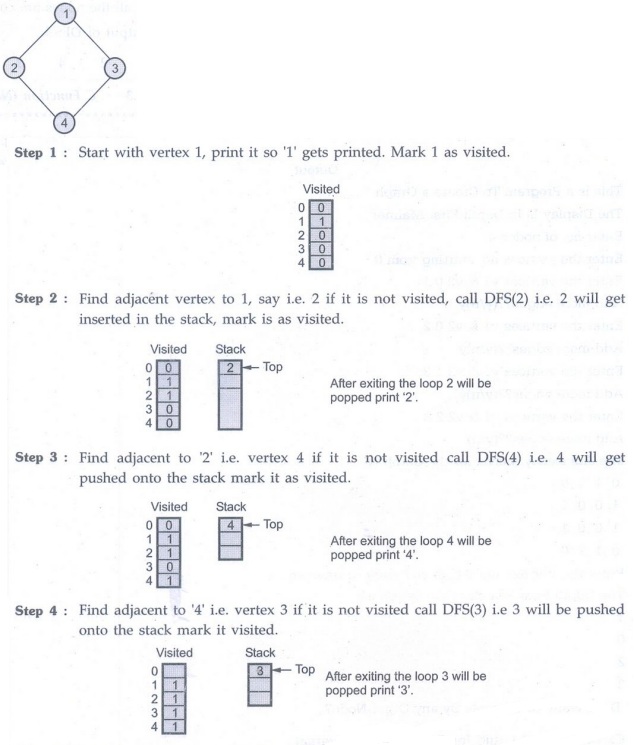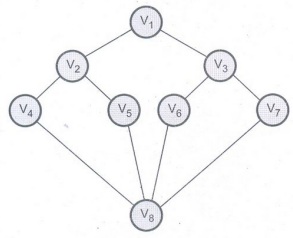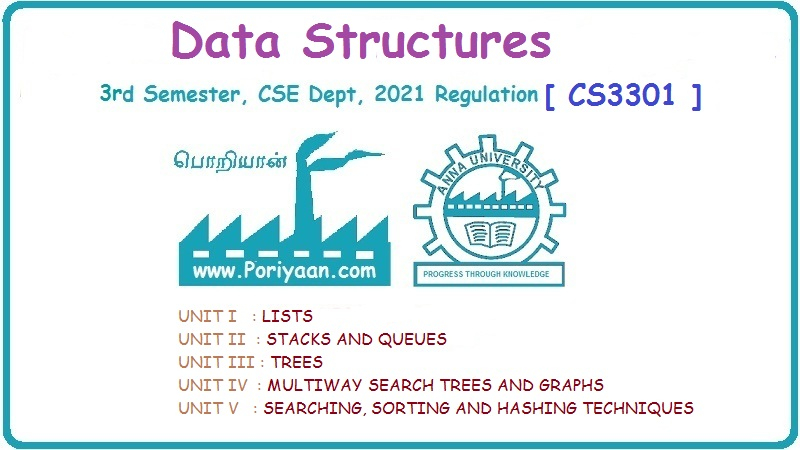Data Structure: Unit IV : Multiway Search Trees and Graphs
Graph Traversal Methods
Operations, Algorithm with Example C Programs | Data Structure
The graph can be traversed using Breadth first search and depth first search method.
Graph Traversal Methods
The
graph can be traversed using Breadth first search and depth first search
method. Let us discuss these methods with the help of examples -
Breadth First Traversal
For the
graph to traverse it by BFS, a vertex V1 in the graph will be
visited first, then all the vertices adjacent to V1 will be
traversed suppose adjacent to V1 are (V2 V3, V4...Vn).
So V2, V3….Vn will be printed first. Then
again from V2 the adjacent vertices will be printed. This process
will be continued for all the vertices to get encounterd. To keep track of all
the vertices and their adjacent vertices we will make use of queue data
structure. Also we will make use of an array for visited nodes. The nodes which
are get visited are set to 1. Thus we can keep track of visited nodes.
In short
in BFS traversal we follow the path in breadthwise fashion. Let us see the
algorithm for breadth first search.
Algorithm :
1.
Create a graph. Depending on the type of graph i.e. directed or undirected set
the value of the flag as either 0 or 1 respectively.
2. Read
the vertex from which you want to traverse the graph say Vi.
3.
Initialize the visited array to 1 at the index of Vi.
4.
Insert the visited vertex Vi in the queue.
5. Visit
the vertex which is at the front of the queue. Delete it from the queue and
place its adjacent nodes in the queue.
6.
Repeat the step 5, till the queue is not empty.
7.
Stop.
1. BFS (non-recursive) For Adjacency Matrix
Ex. 5.1 'C'
Program
/******************************************************************
Program
to create a Graph. The graph is represented using Adjacency Matrix.
*****************************************************************/
#include<stdio.h>
#include<conio.h>
#include<stdlib.h>
#define
size 20
#define
TRUE 1
#define
FALSE O
/*
int
g[size][size];
int
visit[size];
int Q[size];
int front,
rear;
int n;
void
main()
{
int v1,
v2;
char ans
='y';
void
create(),bfs();;
clrscr();
create();
clrscr();
printf("The
Adjacency Matrix for the graph is \n");
for (v1
= 0; v1 < n; v1++)
{
for (v2
= 0; v2 < n; v2++)
printf("%d
", g[v1][v2]);
printf("\n");
}
getch();
do
{
for (v1
= 0; v1 < n; v1++)
visit
[v1] = FALSE;
clrscr();
printf("Enter
the Vertex from which you want to traverse ");
scanf("%d",
&v1);
if (v1
>= n )
printf("Invalid
Vertex\n");
else
{
printf("The
Breadth First Search of the Graph is \n");
bfs(v1);
getch();
}
printf("\nDo
you want to traverse from any other node?");
ans=getche();
}
while(ans=='y');
exit(0);
}
void
create()
{
Int v1,
v2;
char
ans='y';
printf("\n\t\t
This is a Program To Create a Graph");
printf("\n\t\t
The Display Is In Breadth First Manner");
printf("\nEnter
no. of nodes");
scanf("%d",&n);
for (v1=
0; v1 < n; v1++)
for (v2
= 0; v2 < n; v2++)
g[v1][v2]
= FALSE;
printf("\nEnter
the vertices no. starting from 0");
do
{
printf("\nEnter
the vertices v1 & v2");
scanf("%d
%d", &v1, &v2);
if (v1
>= n || v2 >= n)
printf("Invalid
Vertex Value\n");
else
{
g[v1][v2]=TRUE;
g[v2][v1]
= TRUE;
}
printf("\n\nAdd
more edges??(y/n)");
ans=getche();
}while(ans
=='y');
}
void
bfs(int v1)
{
int v2;
visit
[v1] = TRUE;
front
rear = -1;
Q[++rear]
= v1;
while
(front != rear)
{
v1 =
Q[++front];
printf("%d\n",
v1);
for ( v2
= 0; v2 < n; v2++)
{
if
(g[v1][v2]==TRUE && visit [v2]==FALSE)
{
Q[++rear]
= v2;
visit
[v2]: TRUE;
}
}
}
}
Output
This is
a Program To Create a Graph
The
Display Is In Breadth First Manner
Enter
no. of nodes 4
Enter
the vertices no. starting from 0
Enter
the vertices v1 & v2
01
Add more
edges??(y/n)y
Enter the
vertices v1 & v2
02
Add more
edges??(y/n)y
Enter
the vertices v1 & v2
13
Add more
edges??(y/n)y
Enter
the vertices v1 & v2
23
Add more
edges??(y/n)
The
Adjacency Matrix for the graph is
0 1 1 0
1 0 0 1
1 0 0 1
0 1 1 0
Enter
the Vertex from which you want to traverse 0
The
Breadth First Search of the Graph is
0
1
2
3
Do you
want to traverse from any other node?
Enter
the Vertex from which you want to traverse 1
The
Breadth First Search of the Graph is
1
0
3
2
Do you
want to traverse from any other node?
Explanation of logic of BFS
In BFS
the queue is maintained for storing the adjacent nodes and an array 'visited'
is maintained for keeping the track of visited nodes i.e. once a particular node is visited it should not be revisited
again. Let us see how our program works.

So
output will be - BFS for above graph as
1 2 3 4
C Function for BFS using Adjacency List
/*
Global declarations */
typedef
struct node
{
int
vertex;
struct
node *next;
}node;
/*
Declare an adjacency matrix for storing the graph */
node
*head[10];
int
visited[MAX];
int Queue[MAX];
int
front, rear;
int n;
void
bfs(int V1)
{
int i;
node
*first;
front=-1;
rear=-1;
Queue[++rear]
= V1;
while
(front != rear)
{
i =
Queue[++front];
if
(visited[i] == FALSE)
{
printf("%d\n",
i);
visited[i]=
TRUE;
}
first=head[i];
while
(first != NULL)
{
if
(visited[first->vertex] == FALSE)
Queue[++rear]
= first->vertex;
first=first->next;
}
}
}
Depth First Traversal
• In
depth first search traversal, we start from one vertex, and traverse the path
as deeply as we can go. When there is no vertex further, we traverse back and
search for unvisited vertex.
• An
array is maintained for storing the visited vertex.
For example:

• The
DFS will be (if the source vertex is 0) 0-1-2-3-4.
• The
DFS will be (if we start from vertex 3) 3-4-0-1-2.
DFS by Adjacency Matrix (Recursive Program)
Ex. 5.2
'C' Program
/****************************************************************
Program
to create a Graph. The graph is represented using Adjacency Matrix.
****************************************************************/
#include
<stdio.h>
#include<conio.h>
#include<stdlib.h>
/* List
of defined constants */
#define
MAX 20
#define
TRUE 1
#define
FALSE O
/*
Declare an adjacency matrix for storing the graph */
int
g[MAX][MAX];
int
v[MAX];
int n;
void
main()
{
/* Local
declarations */
int v1,
v2;
char
ans;
void
create();
void
Dfs(int);
clrscr();
create();
clrscr();
printf("The
Adjacency Matrix for the graph is \n");
for (v1
= 0; v1 < n; v1++)
{
for (v2
= 0; v2 < n; v2++)
printf("%d
", g[v1][v2]);
printf("\n");
}
getch();
do
{
for (v1
= 0; v1 < n; v1++)
v[v1] =
FALSE;
clrscr();
printf("Enter
the Vertex from which you want to traverse :");
scanf("%d",
&v1);
if (v1
>= MAX)
printf("Invalid
Vertex\n");
else
{
printf("The
Depth First Search of the Graph is \n");
Dfs(v1);
}
printf("\n
Do U want To Taverse By any Other Node?");
ans=getch();
}
while(ans=='y');
}
void
create()
{
int ch, v1,
v2, flag;
char
ans='y';
printf("\n\t\t
This is a Progrm To Create a Graph");
printf("\n\t\t
The Display Is In Depth First Manner");
getch();
clrscr();
flushall();
for (v1
= 0; v1 < n; v1++)
for (v2
= 0; v2 < n; v2++)
g[v1][v2]=FALSE;
printf("\nEnter
no. of nodes");
scanf("%d",
&n);
printf("\nEnter
the vertices no. starting from 0");
do
{
printf("\nEnter
the vertices v1 & v2");
scanf("%d
%d", &v1, &v2);
if (v1
>= n || v2 >= n)
printf("Invalid
Vertex Value\n" );
else
{
g[v1][v2]
= TRUE;
g[v2][v1]
= TRUE;
}
printf("\n\nAdd
more edges??(y/n)");
ans=getche();
}
while(ans=='y');
}
void
Dfs( int v1)
{
int v2;
printf("%d\n",
v1);.
for ( v2
= 0; v2 < MAX; v2++)
if
(g[v1][v2] == TRUE && v[v2] == FALSE)
Dfs(v2);
}
Output
This is
a Program To Create a Graph
The Display Is In Depth First Manner
Enter no. of nodes 4
Enter
the vertices no. starting from 0
Enter
the vertices v1 & v2 0 1
Add more edges??(y/n)y
Enter
the vertices v1 & v2 0 2
Add more
edges??(y/n)y
Enter
the vertices v1 & v2 1 3
Add more
edges??(y/n)y
Enter
the vertices v1 & v2 2 3
Add more
edges??(y/n)
The
Adjacency Matrix for the graph is
0 1 1 0
1 0 0 1
1 0 0 1
0 1 1 0
Enter
the Vertex from which you want to traverse: 1
The
Depth First Search of the Graph is
1
0
2
3
Do U
want To Traverse By any Other Node?
Explanation of Logic for Depth First Traversal
In DFS
the basic data structure for storing the adjacent nodes is stack. In our
program we have used a recursive call to DFS function. When a recursive call is
invoked actually push operation gets performed. When we exit from the loop pop
operation will be performed. Let us see how our program works.

Since
all the nodes are covered stop the procedure.
So
output of DFS is
1 2 4 3
Ex. 5.3 C Function (Non-recursive)
/****************************************************************
Program
to create a Graph. The graph is represented using
Adjacency
Matrix (Non recursive program)
***************************************************************/
#include<stdio.h>
void
Dfs(int v1)
{
int v2;
void
push(int item);
int
pop();
push(v1);
while(top!=
-1)
{
v1=pop();
if(v[v1]==FALSE)
{
printf("\n%d",v1);
v[v1]=TRUE;
}
for (v2
= 0; v2 < n; v2++)
if
(g[v1][v2] == TRUE && v[v2]==FALSE)
push(v2);
}
}
void
push(int item)
{
st[++top]=item;
}
int
pop()
{
int
item;
item=st[top];
top--;
return
item;
}
Ex. 5.4 C Function - Adjacency List
typedef
struct node
{
int
vertex;
struct
node *next;
}node;
/*
Declare an adjacency matrix for storing the graph */
node
*head[MAX]; /*Array Of head nodes*/
int
visited[MAX]; /*visited array for checking whether the array is visited or
not*/ void Dfs(int V1)
{
int V2;
node
*first;
printf("%d\n",
V1);
visited[V1]=TRUE;
first =
head[V1];
while
(first != NULL)
if
(visited [first->vertex] == FALSE)
Dfs
(first->vertex);
else
first
first ->next;
}
Ex. 5.8.1 Define DFS and BFS graph. Show DFS
and BFS for the graph given below.

Sol. :
DFS
Refer section 5.8.2.
BFS
Refer section 5.8.1.
BFS for given graph

Now
delete each vertex from Queue and print it as BFS sequence:
V1 V2 V3
V4 V5 V6 V7 V8
DFS for given graph

As all
nodes are visited so.
DFS of
graph = V1, V2
Ex. 5.8.2 For the following construct:
i) Adjacency matrix
ii) Adjacency list
iii) DFS search
iv) BFS search

iii) DFS :
1 2 5 4
63
iv) BFS :
1 2 3 5
64
Ex. 5.8.3 From the Fig. 5.8.3, in what order are
the vertices visited using DFS and BFS starting from vertex A? Where a choice
exists, use alphabetical order.

Difference between DFS and BFS

Review Questions
1.
Distinguish between breadth first search and depth first search with example.
2.
Explain depth first and breadth first traversal.
Data Structure: Unit IV : Multiway Search Trees and Graphs : Tag: : Operations, Algorithm with Example C Programs | Data Structure - Graph Traversal Methods
Related Topics
Related Subjects
Data Structure
CS3301 3rd Semester CSE Dept | 2021 Regulation | 3rd Semester CSE Dept 2021 Regulation
